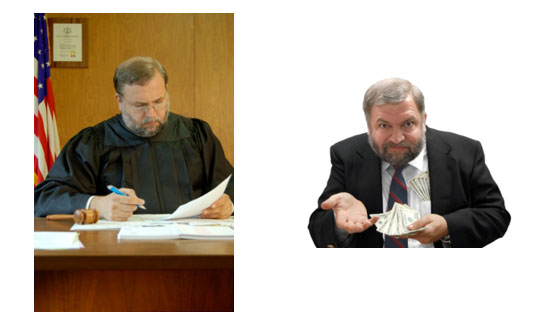A recurring theme we’re hearing from people who sell their images in online stock agencies is that if you have fun with your photos, the sales will follow.
This stock photographer dresses like a Viking and a pirate… even a judge to fill his portfolio with fun people shots. Scroll down to see some of his best-sellers and get his advice on getting started.
COMPUTER PROGRAMMER TURNED STOCK PHOTOGRAPHER
An interview with stock photographer Jerry Koch in Portland, OR
BONNIE: Hi Jerry. Can I start by asking about your background? Have you always been a photographer, or did you come to it from another profession?
JERRY: I’ve been a photography hobbyist for a very long time. Always taking a zillion pictures when on vacation or at family gatherings and often just for fun. My professional background was in computers as a Programmer/Analyst, with over 20 years experience. But I lost my job when the economy went bad. And I had really burned out on the field and wanted a change.
I recognized that photography is my passion and it doesn’t feel like work to me. So, I decided to make photography my profession.
It’s fun and even though I don’t earn the money I did in computers, I’m being paid for what I enjoy and don’t have the stress and aggravation of working for someone else.
BONNIE: What led you to microstock and made you think you could sell your photos through online stock agencies?
JERRY: I have a friend who is a graphics designer who uses stock photos in his work. He noticed my love of photography and suggested I try submitting photos to an online agency to see how I do.
I was skeptical at first, because new photographers get very small royalties upfront. I wasn’t sure if it was worth the effort. At first I held back my best photos because I thought they were worth much more than the small royalty I would get.
And, as expected, things did start out very slowly for me. But over time, more and more of my photos were being downloaded and I devoted more time to photo projects to grow my portfolio.
Now, I find that my online stock portfolio gets me much more exposure than I could get on my own. I don’t have to go through the trouble and expense of printing and framing or matting photos to try to sell at the Portland Saturday Market, or some such venue.
BONNIE: How do you come up with concepts for shoots? Do you research what might sell, or follow your own creative interests?
JERRY: I used to try to guess what might sell and tried to do shoots on a concept that I thought would be popular. Sometimes, too, I would do things that I just thought would be fun. And, I found that more often the “fun” shoots got more downloads than the shoots where I was trying for sales. So, I’ve given up on trying to outguess the market and just go for fun ideas.
When I work with models, I try to involve them in the creative process. If the model is having fun, I think it shows and the photos are more interesting. I talk to them about what characters they might be able to play.
Do they have a uniform or outfit that would make them seem like a particular profession or type of person? Or, maybe use a fun setting for the shoot. Or, can we think of an idea like a “social issue?” I like to use humor in my photos and I’ve gotten feedback from all the models I’ve used that they’ve had a great time on my shoots. I think that’s the most important thing: to have fun and be creative and not worry about the money. Even if the photos don’t sell, we had fun shooting them. But I think the fun shows, and the downloads follow.
BONNIE: What’s your favorite thing about stock photography?
JERRY: My idea of what stock photography is has changed since I first started. In the beginning, I recognized “stock photos” as being elements to a graphics designer’s work — that my photos could be used in combination with text and/or other photos to make a finished piece. So, my early photos were of objects: my gold coins and piles of money were the most popular.
But, I wanted to move toward using people in my photos. I thought it would be difficult to use models because of the required Model Release. So, at first, I was my own model. I had an idea for a “judge” shoot. I used my pastor’s office at church, had a black choir robe, took a flag from the sanctuary and put it behind me. I set up the tripod low to make the desk look like a judge’s bench, and I had a gavel. I did a whole series and was surprised at how many people asked me “Are you really a judge?” And that’s my favorite thing about stock photography: making staged situations look real.
I’m a creative person. And, you might think that with photography, you’re just capturing images of real things that are there. But, it’s exciting to me to fool people, or bring make-believe situations to life. Another example is a series of homeless shots. I had a friend dress up as a homeless guy, and went to an area that looked realistic. And many people have asked me how I got a homeless man to sign a model release, since they don’t have address/phone, etc. for the form. But, he wasn’t really homeless at all.
BONNIE: I’ve posted a few of your photos below. In them, you appear as a pirate, a judge, a business man, and various other characters. Do you like being your own model?

Travel Photography Resources
5 Dos and 2 Don’ts for Travel Photography
Take Great Photos And Get Paid More For Your Travel Articles
Turning a Photography Hobby into a Monthly Income
The Pros Of Selling Your Images As Stock Photography
16 Mobile Photography Tips And Tricks Every Photographer Should Know


